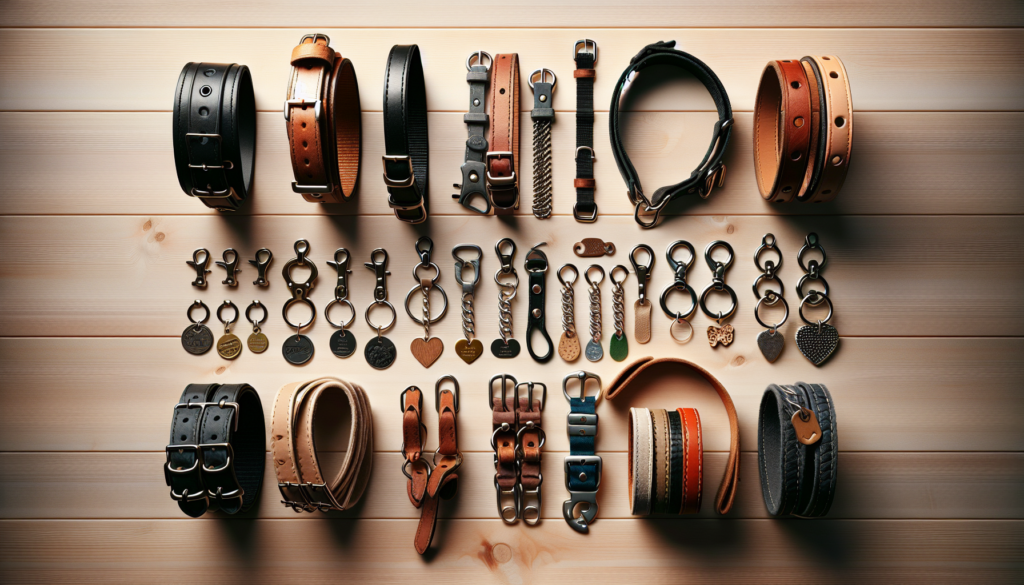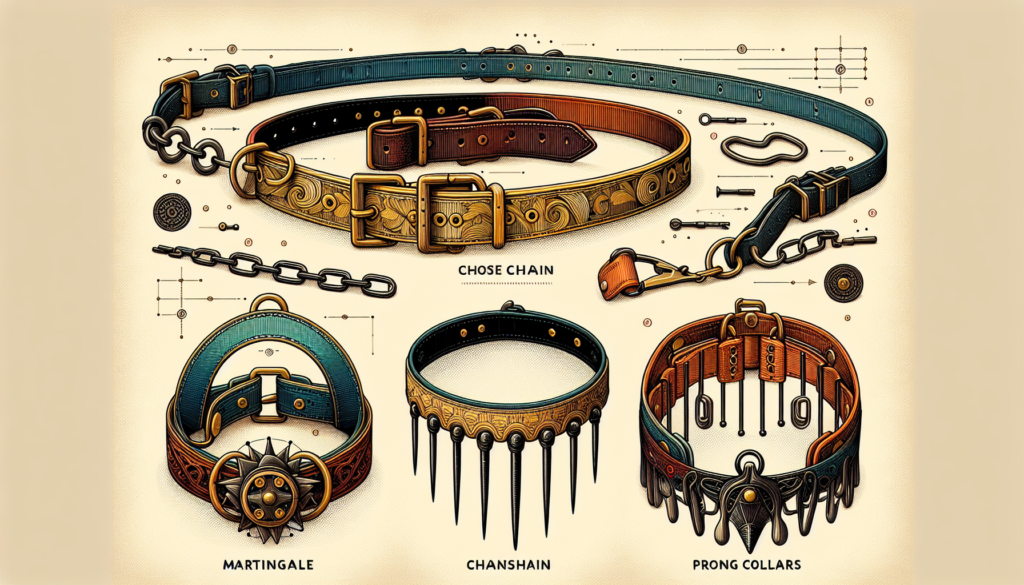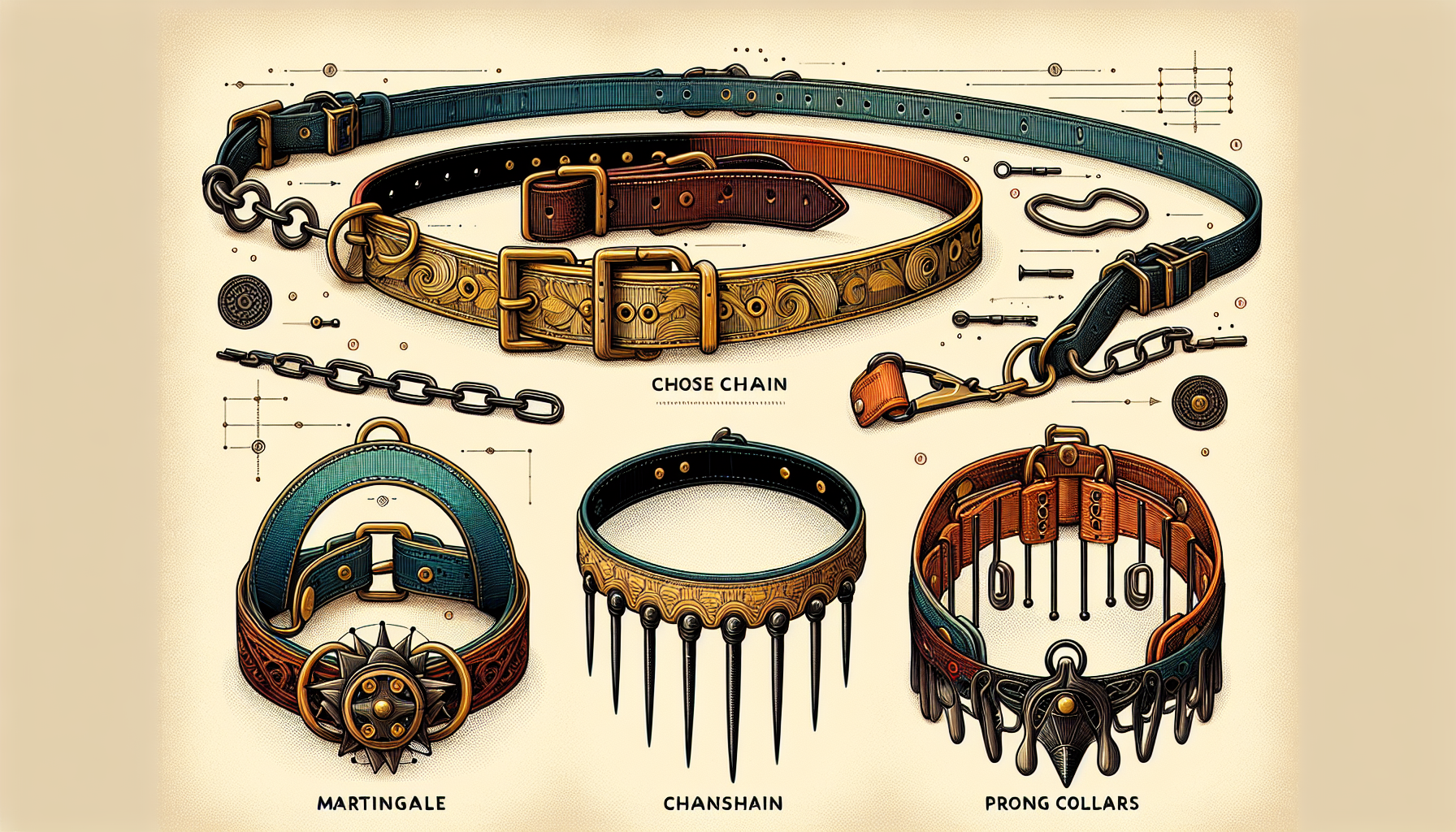In this informative article, you will discover a comprehensive overview of the various types of dog collars available in the market today. From traditional buckle collars to martingales and harnesses, we will explore the unique features and benefits of each style, helping you make an informed decision when selecting the perfect collar for your furry friend. With a focus on safety, comfort, and functionality, this article will provide valuable insights to enhance the well-being of your beloved canine companion.

1. Flat Dog Collars
1.1 Traditional Flat Collar
The traditional flat collar is one of the most common types of dog collars. It is a simple collar made of a flat material such as nylon or leather and is typically secured with a buckle or a quick-release buckle. This collar is suitable for everyday use and comes in a variety of sizes and designs, allowing you to choose the one that matches your dog’s personality and style.
1.2 Rolled Leather Collar
If you are looking for a stylish option that adds a touch of elegance to your dog’s appearance, a rolled leather collar is a great choice. As the name suggests, these collars are made of rolled leather, which offers a softer and more comfortable fit for your furry friend. Rolled leather collars are particularly beneficial for dogs with long or thick fur, as they minimize matting and tangling.
1.3 Martingale Collar
Martingale collars, also known as limited-slip collars, are designed to provide more control over your dog without choking them. These collars feature a loop of material with an additional smaller loop, which tightens when your dog pulls on the leash. The martingale collar is especially useful for dogs with narrow heads or those who are prone to slipping out of regular flat collars.
1.4 Breakaway Collar
Safety should always be a top priority when choosing a collar for your dog. Breakaway collars are specifically designed to ensure the safety of your pet by providing an additional escape mechanism. These collars have a special safety buckle that releases when sufficient pressure is applied, allowing your dog to free themselves if they become entangled or caught on something.
1.5 Safety Stretch Collar
For dogs who tend to pull or lunge on the leash, a safety stretch collar can provide some additional give and flexibility without compromising their safety. These collars have a built-in elastic material that stretches when the dog pulls, reducing the impact on their neck and throat. Safety stretch collars are commonly used for training purposes or with dogs who have respiratory issues.
2. Martingale Dog Collars
2.1 Standard Martingale Collar
The standard martingale collar is a popular choice for dogs who tend to slip out of traditional flat collars. It consists of a fabric or nylon loop that tightens when the dog pulls on the leash, providing a gentle correction without choking them. This type of collar is particularly useful for training and walking strong-willed or large dogs.
2.2 Limited-Slip Martingale Collar
Similar to the standard martingale collar, the limited-slip martingale collar offers the same benefits of control and correction while also providing a secure fit. Unlike the standard version, the limited-slip martingale collar has a built-in mechanism that limits the tightening action when the dog pulls, preventing excessive pressure around the neck. This design ensures that your dog stays comfortable while still maintaining control.
3. Prong Collars
3.1 Traditional Prong Collar
Prong collars, also known as pinch collars, are controversial but can be effective tools when used correctly under the guidance of a professional dog trainer. These collars have metal prongs evenly spaced around the collar, which provide a mild form of pressure and discomfort when the dog pulls. The intention is not to hurt the dog but to redirect their attention and discourage pulling.
3.2 Pinch Collar
The pinch collar, like the traditional prong collar, is designed to help control dogs who tend to pull or be overly reactive on the leash. This collar has interlocking metal links with prongs that face inward and apply pressure to the dog’s neck when tension is applied. It is essential to ensure the pinch collar is correctly fitted and used with proper training techniques to prevent any harm to your dog.
3.3 Quick-Release Prong Collar
Safety is paramount when using prong collars, and the quick-release prong collar addresses this concern. This collar features a quick-release mechanism that allows you to easily remove the collar in case of an emergency or unexpected situations. While still providing the same corrective benefits as traditional prong collars, the quick-release feature offers an added layer of convenience and peace of mind.
3.4 Plastic Prong Collar
For dogs who are sensitive to metal or for owners who prefer an alternative to traditional prong collars, plastic prong collars can be a suitable alternative. These collars have the same design as their metal counterparts but are made of durable plastic. Plastic prong collars offer a gentler alternative while still providing effective control and correction when used appropriately.
4. Head Collars
4.1 Gentle Leader
The Gentle Leader is a popular head collar that gives you control over your dog’s head and neck, redirecting their attention and discouraging pulling. This collar has a strap that goes around the base of the dog’s nose and another strap that goes behind their ears. The design of the Gentle Leader allows you to steer and guide your dog’s movements more effectively, making it a valuable tool for training or managing reactive behavior.
4.2 Halti Head Collar
Similar to the Gentle Leader, the Halti Head Collar is designed to provide control over your dog’s head, reducing their ability to pull or lunge on the leash. It consists of a nose strap and a head strap that work together to gently redirect the dog’s attention without causing discomfort or pain. The Halti Head Collar is a popular choice for dogs of all sizes, offering an effective solution for leash training and behavior management.
4.3 New Trix Head Collar
The New Trix Head Collar is another head collar option that allows you to control your dog’s movements through gentle guidance. This collar features an adjustable strap that wraps around the top of the dog’s head and another strap that goes under the dog’s chin. By providing control at the head and neck, the New Trix Head Collar offers a humane and effective way to manage leash pulling and improve overall obedience.
4.4 Canny Collar
The Canny Collar is specifically designed to prevent dogs from pulling on the leash and gaining control during walks. It consists of a nose strap and a collar that connects to the dog’s regular collar. The Canny Collar applies gentle pressure around the dog’s nose when they pull, encouraging them to move back into a more controlled position. This collar is known for its simplicity and effectiveness in discouraging pulling behavior.

5. Harnesses
5.1 Back-clip Harness
Back-clip harnesses are a popular choice for small to medium-sized dogs who require minimal control during walks. These harnesses have a D-ring on the back, making it easy to attach a leash. The back-clip design helps distribute pressure more evenly across the dog’s body and reduces strain on their neck and throat. Back-clip harnesses are generally more comfortable for dogs who don’t pull excessively.
5.2 Front-clip Harness
Front-clip harnesses are an excellent option for dogs who tend to pull, as they redirect their forward motion when tension is applied to the leash. These harnesses have a D-ring on the front chest area, allowing you to attach the leash at a point of control. When the dog pulls, the front-clip harness encourages them to turn towards you, discouraging pulling behavior and promoting better leash manners.
5.3 Dual-clip Harness
Dual-clip harnesses offer versatility and flexibility for different walking situations. These harnesses have both front and back attachment points, allowing you to choose which one is most suitable for your dog’s needs. The front attachment discourages pulling, while the back attachment offers a more relaxed walking experience. Dual-clip harnesses provide options for training, control, and comfort, making them a popular choice among dog owners.
5.4 No-pull Harness
Designed specifically to tackle pulling issues, no-pull harnesses provide additional control and discourage dogs from pulling excessively. These harnesses typically have a front attachment point that helps redirect the dog’s forward movement when they pull. The unique design of the no-pull harness redistributes the pressure across the chest and shoulder area, reducing strain and discomfort while still providing effective control.
6. Choke Chains
6.1 Slip Collar
Slip collars, also known as choke chains, are designed to provide quick and effective correction when used correctly. These collars consist of a metal chain with two rings at each end, forming a loop. The collar tightens when tension is applied to the leash, mimicking the natural correction a dog would receive from their mother or pack leader. Slip collars should only be used under the guidance of a professional dog trainer to prevent injury or discomfort.
6.2 Fur Saver Collar
Fur saver collars are a variation of the slip collar but have additional features to protect your dog’s fur and prevent matting or tangling. These collars have larger, smoother links that are gentler on the coat and less likely to cause hair breakage. The fur saver collar still provides the necessary correction when the leash is pulled, making it an effective tool for training and control.
6.3 Chain Martingale Collar
The chain martingale collar combines the benefits of a slip collar and a martingale collar. It features a chain loop that tightens when the dog pulls but has limited slip functionality to prevent choking. The chain martingale collar offers more control and correction than a traditional flat collar while still ensuring the dog’s safety and comfort.
6.4 Loop Martingale Collar
The loop martingale collar is an alternative to traditional chain or fabric martingale collars. It features a looped design made of nylon or fabric, which offers a gentler correction while still providing effective control. The loop martingale collar is particularly suitable for dogs with sensitive skin or those who may be uncomfortable with the pressure of a chain collar.
7. Breakaway Collars
7.1 Traditional Breakaway Collar
Traditional breakaway collars are designed with safety in mind. These collars have a special buckle that releases under pressure, allowing the dog to break free if they become entangled or caught on something. Breakaway collars are especially recommended for cats or small dogs who may be at higher risk of getting trapped in narrow spaces.
7.2 Safety Buckle Breakaway Collar
The safety buckle breakaway collar is an enhanced version of the traditional breakaway collar. It features a buckle mechanism that ensures a more secure fit while still maintaining the ability to release under pressure. The safety buckle breakaway collar offers peace of mind, preventing accidental escapes while allowing for quick and easy release in emergencies.
8. Electronic Collars
8.1 Static Correction Collar
Static correction collars, also known as shock collars, are electronic devices that provide a static correction or mild shock to discourage unwanted behavior. These collars have varying levels of intensity that can be adjusted to match your dog’s temperament and sensitivity. Static correction collars should only be used as a last resort under the guidance of a professional trainer and should never be used as a punishment.
8.2 Vibration Collar
Vibration collars offer an alternative to static correction collars and are often used for training or communication purposes. These collars emit a vibration or buzzing sensation to get your dog’s attention or signal cues. Vibration collars can be effective for dogs who are deaf or hard of hearing, as they provide a non-auditory form of communication.
8.3 Spray Collar
Spray collars are another type of electronic collar that uses harmless sprays to deter unwanted behavior. These collars typically emit a burst of unscented or citronella spray when triggered to interrupt the dog’s behavior. Spray collars are commonly used for barking control or to discourage dogs from approaching certain areas. It is essential to ensure that the sprays used are safe and non-irritating for your dog.
8.4 Ultrasonic Collar
Ultrasonic collars work by emitting high-pitched ultrasonic sounds that are inaudible to humans but can be heard by dogs. These collars are designed to capture your dog’s attention and deter them from engaging in unwanted behavior. Ultrasonic collars are often used for barking control or to discourage dogs from jumping on furniture or people. They offer a humane and non-intrusive method of communication and correction.
9. GPS Collars
9.1 Basic GPS Tracking Collar
Basic GPS tracking collars are advanced technological devices that use GPS technology to track your dog’s location. These collars have a built-in GPS receiver that communicates with satellites, allowing you to monitor your dog’s whereabouts through your smartphone or computer. Basic GPS tracking collars provide peace of mind, ensuring that you can quickly locate your dog if they wander off or get lost.
9.2 Advanced GPS Tracking Collar
Advanced GPS tracking collars offer additional features and functionalities to enhance the tracking experience. These collars may include features such as geofencing, which allows you to set up virtual boundaries for your dog and receive notifications if they stray beyond the designated area. Some advanced GPS tracking collars also provide activity monitoring, allowing you to track your dog’s daily exercise levels.
9.3 Geofencing Collar
Geofencing collars provide an added layer of security by allowing you to set up virtual boundaries or safe zones for your dog. These collars utilize GPS technology to track your dog’s location and send alerts to your smartphone or computer if your dog leaves the designated area. Geofencing collars are particularly useful for dogs who tend to wander or for owners who live in areas with potential escape routes.
10. Training Collars
10.1 Citronella Collar
Citronella collars are training collars that use citronella spray to discourage unwanted behavior. These collars have a built-in mechanism that releases a burst of citronella scent when triggered, deterring dogs from barking excessively or engaging in other undesirable activities. Citronella collars provide a humane and natural alternative to electronic collars, offering a gentle correction without any harm to your dog.
10.2 Sound Collar
Sound collars, also known as sonic collars, use a high-pitched sound to interrupt your dog’s barking or undesirable behavior. These collars emit a sound frequency that can be heard by dogs but is generally not audible to humans. Sound collars are effective in training dogs to stop barking without using any physical correction or discomfort.
10.3 Shock Collar
Shock collars, also referred to as electronic collars, are training tools that deliver a mild electric shock to discourage dogs from engaging in unwanted behavior. These collars have adjustable levels of intensity and should only be used under the guidance of a professional dog trainer. It is important to note that shock collars should never be used as a form of punishment, but rather as a means of communication and redirection.
10.4 Clicker Collar
Clicker collars, also known as clicker training collars, are designed to reinforce positive behavior through the use of a clicker sound. The clicker serves as a marker or signal that indicates to the dog that they have performed the desired behavior correctly. Clicker collars are commonly used in conjunction with positive reinforcement training methods to promote learning and obedience in dogs.

